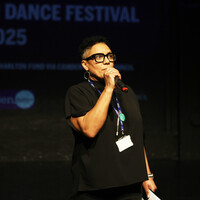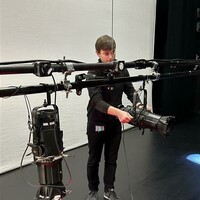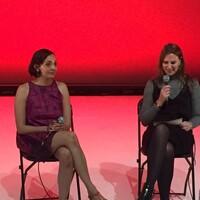Exploring Hip Hop and pushing boundaries in dance with Mikey J and Boy Blue
News Story
How can dance practitioners go out into the creative sector with skills that will be relevant and applicable to the world around us? Here’s how students from London Contemporary Dance School do this as part of our work with Michael ‘Mikey J’ Asante MBE and Boy Blue.
At London Contemporary Dance School (LCDS), we’re known for pushing the boundaries so our dancers are always relevant. That’s why our curriculum is proudly international, exposing students to dance practices that reflect a global world. To support this, we’ve developed a range of prestigious collaborations and partnerships over many years to ensure students have direct access to the changemakers of our industry.
Michael 'Mikey J' Asante MBE is a renowned producer, composer, singer, dancer and DJ. His 20-year career history is firmly etched in the UK urban music industry, and he was awarded an MBE for services to Hip Hop Dance and Music in the Queen's New Year’s Honours list in 2022. He is also the Co-Founder and Co-Artistic Director of Boy Blue, a Hip Hop dance theatre company.

Students benefit from the expertise of Mikey J and Boy Blue in many ways. This includes Mikey J working alongside LCDS teacher Vicky 'Skytilz' Mantey on the Groove module in the first year. Additionally, Mikey J teaches DJing to second year students in the Pillars of Hip Hop series, where students have workshops on the different elements of Hip Hop outside of dancing. Boy Blue also delivers part of the second year Hip Hop Project. As well as contributing to student learning, Mikey J is a member of the Board of Governors at The Place.
The influence of Hip Hop
“I think a lot of other art forms focus on where they’ve been,” Mikey J said. “Hip Hop as a cultural movement is very ‘now’. It’s a real cultural measure of where we’ve been and where we are. I’ve seen so many different pieces, especially from a lot of contemporary artists, whose practice has been affected by it.”
Mikey J believes that incorporating Hip Hop into the curriculum at LCDS contributes to the school’s DNA to innovate and push the boundaries. “Even 50 years ago, LCDS was bucking the trends, being radical in the thought process to break away from the ‘standard’ in dance training,” Mikey J explained. “It’s a forward-thinking, very curious space constantly moving towards being current. Now there’s even more opportunity to expand the idea of what someone can do in dance.”
The representation of Hip Hop and street dance in the industry has increased significantly in recent years, and it now pervades film, television and theatre. Giving students skills and understanding of this genre makes them more relevant in a quickly changing industry. “These skills have always been considered valuable, but they’re now seen as being essential for young artists coming into the industry,” said Vicky 'Skytilz' Mantey, who teaches at LCDS. “It can also be a part of impacting change – de-colonising and dismantling practice hierarchy. Being part of an institution that is inclusive of Hip Hop related dance forms and street dance is important to me. When I was at the age of going into university, there weren't any higher education institutions that were inclusive of street dance and Hip Hop.”
Maximising the future potential of dancers
Something that makes Hip Hop so versatile is that dancers can take aspects of it into their own practice. “It has an iterative notion of creativity,” Mikey J said. “You can study it, take some of its ‘source code’, and implement it into any of your practices. It’s totally inclusive, it allows you to create , and it will always unlock more than you think.”
Mikey J believes dance and the creative industries are experiencing a unique moment in time. He said: “You look at influencers and YouTubers, technology and social trends. So many of them include movement. Dance and movement will always be relevant.”
The wider creative sector has more opportunities than ever before too. “The LCDS alumni community is strong,” Mikey J said. “As well as dancers, graduates can be directors, lighting designers, producers… all the different parts of what the industry needs. They add to the creative industry as a whole, which is a multi-billion pound industry. There is a consistency that lives within LCDS. The people who come through the school go on to do interesting things and move into the industry in some way, shape or form. LCDS is part of the beginning of so many important individuals in the dance community.”


